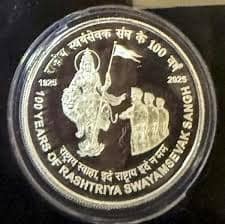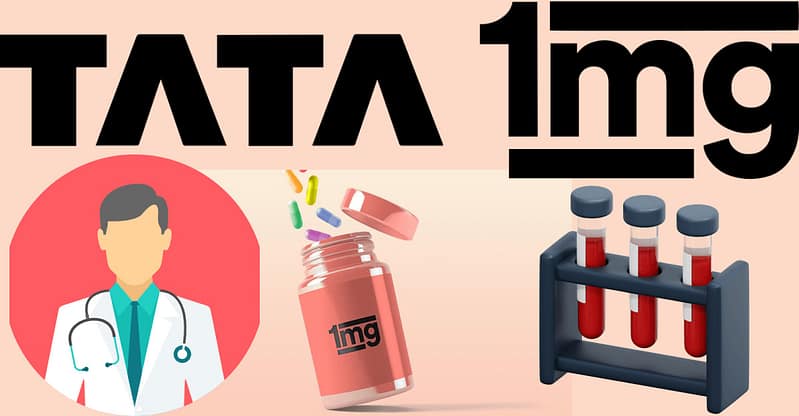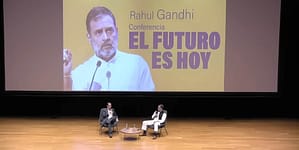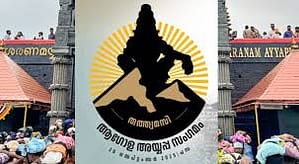Hindutva is a right-wing ethno-nationalist political ideology that defines the cultural identity of India in terms of Hinduism. The term “Hindutva” was first defined in the early 1920s by Indian nationalist and politician Vinayak Damodar Savarkar. Today it is most closely associated with the Bharatiya Janata Party, one of the main political parties in India, and the Rashtriya Swayamsevak Sangh, a non-political Hindu nationalist paramilitary organization. Hindutva supporters, or Hindutvavadis, claim to advocate for India’s significant Hindu-majority population—as of 2011, India was 79.8 percent Hindu, 14.2 percent Muslim, and the rest a mix of Christians, Sikhs, and others—and seek to redefine the idea of secularism enshrined in the Indian constitution in terms of Hindu rights.
Hindutva as an ideology must be understood as distinct from Hinduism as a religion—not all adherents of Hinduism subscribe to Hindutva—and Savarkar’s original definition asserts Hindutva as an ethnic category and eschews a specific religious connotation. In current practice, the ideology tends to be strongly pro-Hindu. However, supporters often define Hindutva in purely cultural terms as a “way of life.”
The term Hindutva was first used in a nationalist political context by Savarkar in his 1923 booklet Essentials of Hindutva. Savarkar, a militant voice for Indian independence from British colonial rule, was writing against the backdrop of the Khilafat movement, a pan-Islamic attempt led by Indian Muslims to support the caliphate in Istanbul after the fall of the Ottoman Empire. Mahatma Gandhi and others in the Indian National Congress (Congress Party) collaborated with Muslims in that movement, but Savarkar saw the Muslim community’s solid organization and the prospect of a pan-Islamic identity as a threat to Indian Hindus. Savarkar proposed that Indian identity ought to be based on a common ancestry and culture intimately and religiously tied to the land of India. Hindus were thus defined not as followers of Hinduism specifically but as people who share the Indian culture and consider India religiously significant, as opposed to others whose religious history and identity are rooted elsewhere. In this view, Sikhs, Jains, Buddhists, and even Indian atheists are included with Hindus, as their religious identities are tied to geographical locations and historical events situated within the Indian subcontinent. Savarkar opined that Muslims and Christians, whose religious histories took place elsewhere, would necessarily have a divided loyalty to India.
Savarkar went on to lead the conservative Hindu Mahasabha and his ideas were propagated by the RSS, which was founded by K.B. Hedgewar in 1925 and, from 1940 was led by M.S. Golwalkar, who clearly defined the Hindutva ideology in terms of Hindu religious superiority while maintaining the RSS as an apolitical group.
Under the umbrella of the RSS, the Hindutva movement created numerous offshoot groups to mobilize supporters and promote its causes among specific communities. The collection of groups is called the Sangh Parivar. Significant bodies include the religious Vishwa Hindu Parishad,the militant Bajrang Dal the student-centered Akhil Bharatiya Vidyarthi Parishad and the education-focused Vidya Bharati and Seva Bharati, the omnipresent social service force that reaches place when society is struck in distress.The public service-oriented Rashtra Sevika Samiti (National Women’s Volunteer Committee) operates as a women’s version of the all-male RSS.
In line with their Hindu-first ideology, Hindutva advocates have promoted several specific policies concerning the treatment of religious minorities. A particular cause célèbre of Hindutva is the cow protection (gau raksha) movement. Cow-protectionist Hindus, who hold cows to be sacred, Hindutva groups further promote the “homecoming” (ghar wapsi), or (re)conversion, of Muslims and Christians to Hinduism. A major post-independence policy proposal among Hindutva supporters is a Uniform Civil Code (UCC) to replace separate sets of “personal laws” regarding matters such as marriage and inheritance, which allow Indians of different religions to follow laws specific to their traditions. For Hindutvavadis, the lack of a UCC amounts to special treatment for Muslims and other religious minorities. Supporters also oppose the practice of reservations, or quotas in education and employment, for religious minorities, which they argue creates undue favoritism for minority religions and is an abandonment of religion-neutral secularism.
Migrations of Hindus and Muslims after partition, Indians crowding onto trains during the partition of India into a predominantly Hindu state (India) and a predominantly Muslim state (Pakistan) in one of the largest population transfers in history, 1947.
In the lead-up to independence, Hindu nationalists adopted the ideology of Akhand Bharat (“Undivided India”), which insists upon the Indian subcontinent’s geographical and cultural unity under Hindu majoritarian rule. That ideal was threatened by the 1947 partition of India, which divided the country into a Hindu-majority country (India) and a Muslim-majority country (Pakistan) and resulted in the deaths of hundreds of thousands and the displacement of millions in the ensuing mass migrations and communal riots. Members of the Hindu right wing blamed leaders of the Indian National Congress, especially Gandhi, for both the carnage and the division of the Indian subcontinent. As Gandhi actively campaigned for peaceful coexistence between Hindus and Muslims in India, frustrations among Hindu nationalists intensified. On January 30, 1948, Gandhi was assassinated by Nathuram Godse, a former RSS member who had switched his allegiance to the Hindu Mahasabha. The Indian government responded by banning the RSS, but subsequent investigations absolved the RSS leadership of any role in the assassination, and the ban was lifted in 1949.,
The typically apolitical RSS began a foray into politics in 1951 when they—along with Syama Prasad Mukherjee, former head of the Hindu Mahasabha—formed the political party Bharatiya Jana Sangh within the growing Sangh Parivar fold. The Jana Sangh found political success in 1977 when it came into power in the Lok Sabha (lower house of parliament) as part of the Janata Party coalition government led by Morarji Desai. After that coalition collapsed in 1979, Vajpayee and other leaders, such as Lal Krishna Advani, reorganized the BJS to form the BJP in 1980.
In 1984 the VHP launched the Ram Janmabhoomi movement to build a Ram temple in Ayodhya, which Hindus believe to be the birthplace of the Hindu deity Rama. It was a disputed site because the Babri Masjid, a Mughal-era mosque, stood at the site. The BJP joined the Ram Temple movement in 1989 and won significant electoral gains in the 1989 parliamentary elections. In an effort to broaden the BJP’s base, Advani launched a political rath yatra (“chariot tour”) across India in 1990 to mobilize support for building a temple dedicated to Rama in Ayodhya. Thousands of kar sevaks (volunteers for a religious cause) joined Advani’s rath yatra in a show of strength. On December 6, 1992, a mob of militant kar sevaks demolished the Babri Masjid, an event that was followed by communal riots across the country. In 1993, the Central Bureau of Investigation (CBI) charged several BJP and VHP leaders for inciting the kar sevaks to destroy the mosque. After several twists and turns in this and other related cases, on September 30, 2020, a special CBI court acquitted all the accused of criminal charges, saying the demolition happened in the spur of the moment and there was no conspiracy. The ideas of Hindutva and Hindu majoritarianism rose in prominence as communal fault lines hardened in the 1990s. In 1996, the BJP became the largest single party in the Lok Sabha. A BJP-led coalition (the National Democratic Alliance; NDA) came to power in 1998 but lost power in 2004. Narendra Modi was elected to office in 2014. He won a second term in 2019 and was sworn in for a third term on June 9, 2024.
Hindu nationalism saw a revival in 2014 as the BJP returned to power in India’s parliament. The BJP, with Narendra Modi as its candidate for prime minister, won a clear majority in the 2014 parliamentary elections and further increased its vote share in 2019. With a clear mandate in parliament, several long-term Hindutva demands were met. In 2019 Jammu and Kashmir—a predominantly Muslim region under India’s de facto control that was given semi-autonomous status after partition—had its semi-autonomous status revoked. This had been a long-term priority for the BJP under the ideology of Akhand Bharat. In January 2024 the newly built Ram Mandir in Ayodhya was consecrated, and the event was celebrated by the BJP. Although many expected the consecration of the Ram Mandir to give the BJP a boost in the 2024 Lok Sabha elections, the party surprisingly failed to secure a majority on its own, even though the BJP-led National Democratic Alliance (NDA) managed to go past the required 272-seat mark and formed the government at the center. What was even more surprising was the fact that the BJP lost in the constituency of Faizabad, where Ayodhya (the site of the Ram temple) is located. Experts opine that issues like price rise and unemployment may have affected which way the votes went, in addition to minority groups possibly favoring the Samajwadi Party.
In recent years, critics have objected to the BJP government’s renaming of cities and roads bearing Mughal-era names to Hindu names—such as the renaming of Allahabad city to Prayagraj and Mughalsarai Junction railway station to Deen Dayal Upadhyay Junction railway station—and have pointed out that these changes are motivated by a Hindu nationalist ideology. The ruling BJP government’s use of the name Bharat for India in placards identifying the prime minister and the president in the 2023 G20 summit, which India hosted, also sparked speculation that the country may be renamed to just “Bharat.” The traditional practice was to use “India” in placards and in English communications and “Bharat” in Indian languages. The practice of changing education and place-names to focus on India as a primarily Hindu nation is often called “saffronisation” for the distinctive saffron-orange color associated with the BJP and Hindu nationalism. The BJP, like governments that came before it, has also been accused of influencing the content of texts created by the National Council of Educational Research and Training (NCERT), an autonomous organization set up by the Government of India to provide advice on school education in state and central education boards. In 2024 the NCERT came under sharp criticism for “saffronising education” from educators as it pruned some details on the Babri Masjid demolition, calling it a “three-domed structure” instead of naming it, and deleting references to the BJP’s Rath Yatra in the 1990s and details on the communal violence during the period. The NCERT chief defended the changes and said that they focus on the latest Supreme Court verdict on the case instead of dwelling on references to riots to “avoid creating depressed and violent citizens.”
Marking its centenary, the Rashtriya Swayamsevak Sangh stands as a force of discipline, service, and cultural vision. From shaping Swayamsevaks to inspiring nationwide institutions, it has quietly transformed India’s fabric, uniting diversity and redefining true nation-building. As the Rashtriya Swayamsevak Sangh (RSS) enters its 100th year since its founding in 1925, it stands as a towering testament to what quiet conviction, disciplined effort, and a deep-rooted cultural vision can achieve over time. It is not only one of the world’s largest voluntary organisations but also one of the very few institutions that continues to grow a full century after its inception, and more than 85 years after the passing of its founder, Dr Keshav Baliram Hedgewar. While most organisations struggle with relevance or internal decay after such a long period, the RSS has done the opposite. It has grown, matured, and deepened its reach, becoming a living force that has shaped generations of Indians.
From a small group of swayamsevaks in Nagpur to more than 60,000 daily shakhas across the country today, the journey of the RSS is nothing short of transformative. But the real story of the Sangh lies not just in its numbers or structures, but in the kind of human beings it has shaped. Right from the beginning, the RSS’s focus has been on character-building — on creating swayamsevaks who are not just physically strong and mentally alert, but spiritually rooted and morally unshakeable. These are men who have absorbed the ethos of selfless service, discipline, simplicity, and nation-first thinking, not as slogans, but as a way of life.
Over the past century, this approach has borne remarkable fruit. Across fields and geographies, countless men shaped by the RSS have gone on to live lives of quiet sacrifice and extraordinary service. Whether as teachers, doctors, engineers, social activists, or political leaders, they have carried with them the sanskar of service and character. These are not always the names you’ll find in newspaper headlines, but they are the people who have held up the backbone of this nation. From villages in the North-East to metros in the West, from the Himalayan frontiers to the coastal temples of the South, they have lived with dignity, led with humility, and worked with fierce integrity.
In parallel, the Sangh’s influence has given rise to a network of organisations collectively known as the Sangh Parivar, which are pioneers in their own domains. The Vishwa Hindu Parishad has worked tirelessly to preserve and revive India’s cultural and spiritual heritage. The Akhil Bharatiya Vidyarthi Parishad, Vanvasi Kalyan Ashram, Bharatiya Mazdoor Sangh, Seva Bharati, and many others have extended the Sangh’s philosophy of seva and charitra nirman into every corner of the country. Whether it is education, tribal welfare, women’s empowerment, disaster relief, or environmental conservation, RSS-inspired institutions have blazed trails quietly, consistently, and effectively.
Politics, too, has felt the influence of the Sangh, though it has never been the Sangh’s primary goal. Many of India’s tallest leaders today, from the Prime Minister to Chief Ministers, Governors, and Parliamentarians, have been shaped by the values instilled in the shakhas. But what’s important is not just that they hold high office, but that they embody a lifelong commitment to nation-building and public service. In an era where political life is often transactional, many of these leaders stand out because their roots lie in an organisation that values duty over entitlement, sacrifice over spotlight.
The RSS has also played an underappreciated yet critical role in uniting diverse sections of Indian society. While others have stoked divisions in the name of caste or community, the Sangh has patiently built social coordination. It has quietly created platforms where people from different regions, dialects, and traditions come together under the larger banner of Bharatiyata. The idea has always been that diversity is not a problem to be managed, but a treasure to be honoured and united.
This spirit of seva becomes most visible during times of national crisis. Be it the Gujarat earthquake in 2001, the tsunami of 2004, floods in Kerala, or the COVID-19 pandemic, swayamsevaks have consistently been among the first responders. They don’t wait for cameras, don’t ask for credit, they simply act. They set up relief camps, deliver food and medicines, assist in cremations, and rebuild broken communities. This readiness to serve, without any expectation of reward, is the truest expression of the Sangh’s soul.
Beyond service, one of the RSS’s most remarkable contributions has been its long-term transformation of India’s ideological discourse. For decades, the mainstream narrative dismissed the idea of India as a civilisational nation. Indigenous perspectives, spiritual frameworks, and cultural pride were seen as outdated or backward. But the Sangh remained patient. Through daily shakhas, intellectual forums, and grassroots outreach, it kept the flame alive. Today, terms like Bharat, dharmic values, swadeshi, and cultural nationalism are not fringe; they are mainstream. This is not a result of any campaign, but of a century of silent, disciplined work.
The challenges of the next hundred years are vast and evolving, but the RSS has already begun addressing them through its renewed national focus on five core resolutions, or the Panch Pran, that will shape the cultural, moral, and civic ethos of Bharat in the coming era. These are not mere concepts, but lived principles that swayamsevaks across the country are striving to embody in their daily conduct. The first is social harmony — the resolve to dissolve all forms of social discrimination and to build an inclusive, unified society rooted in mutual respect and shared heritage. The second is family enlightenment — strengthening the Indian family unit as a value-based institution where children grow up learning sanskar, responsibility, and moral clarity. The third is environmental protection — a conscious commitment to sustainable living that respects nature not as a resource, but as a sacred presence. The fourth is swadeshi conduct — reviving economic nationalism by embracing indigenous products, technologies, and systems in daily life. The fifth is civic duty — cultivating an alert, active citizenry that not only claims rights but also performs responsibilities with dedication. These five resolves together reflect the Sangh’s vision for a resurgent Bharat, rooted in its civilisation, enriched by its diversity, and led by individuals of deep character and unwavering commitment to the nation.
In a world obsessed with instant fame and shallow influence, the RSS reminds us of the power of patience, character, and rootedness. It remains a unique phenomenon: an organisation that doesn’t advertise, yet inspires; that doesn’t command, yet leads; that doesn’t seek credit, yet transforms lives. And perhaps, that is its greatest contribution to Bharat.
As the Rashtriya Swayamsevak Sangh steps into its centenary, it stands not merely as an institution but as a movement that has reshaped India’s cultural, social, and ideological fabric. From a handful of swayamsevaks in Nagpur to lakhs across the nation, its journey reflects the transformative power of discipline, service, and conviction. Its influence extends far beyond politics, into education, welfare, disaster relief, and the revival of civilisational pride. Rooted in seva and character-building, the Sangh remains a quiet but unshakeable force, reminding us that true nation-building rests on values, unity, and patient, selfless work across generations.
The release of a 100-rupee commemorative coin to mark the centenary celebrations of Rashtriya Swayamsevak Sangh (RSS) by Prime Minister Narendra Modi on Wednesday, October 1, also marks the first-ever depiction of ‘Bharat Mata’ on Indian currency.














